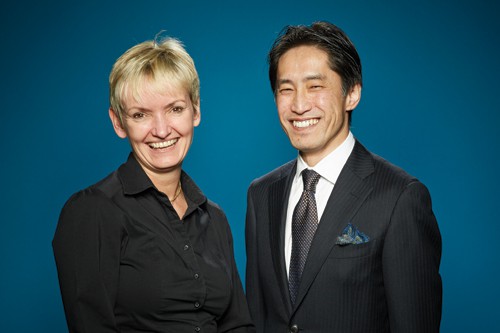
Eight short years on from the merger of Japanese pharmaceutical companies Yamanouchi and Fujisawa, with ten products in launch or early-growth phase and category leadership in oncology, transplantation and urology, Astellas is already rubbing shoulders with industry heavyweights.
Globally the company experienced sales growth of 1.6 per cent last year, with a notable 19.6 per cent of that reinvested into research. But the story is perhaps even more impressive when one homes in on Astellas Pharma Europe (APEL). With the current EU pharma market pacing at a growth rate of 1.2 per cent, APEL has bucked the trend by achieving €1.7bn in sales, representing a very healthy 6 per cent increase over the previous year.
During a time of widespread European recession and austerity, APEL’s success comes down to a combination of factors, explain Kay Drake, vice president of marketing, and Naoki Okamura, senior vice president, chief strategy officer. They point to the firm’s focus on specific therapy areas, strategic partnerships and its commitment to a ten-year vision.
The Astellas story began with the 2005 merger of two Japanese companies: urology specialist Yamanouchi and Fujisawa, which had a strong franchise in transplantation. Okamura explains that this was not only a complementary union from a therapeutic area standpoint, but that the former had a footprint in Europe, while the latter had a presence in the US, which provided the fledgling company with a broad global network.
The vision
“Right after the merger,” says Okamura, “we created VISION 2015, which goes right to the heart of the company, outlining what we should look like over a ten-year timeframe.
“From this vision, we created our Global Category Leadership (GCL) strategy, which involved shaping the company into a category leader in several therapeutic areas with high unmet needs.
“We believe we have already achieved that position in transplantation and urology and we now hope to achieve GCL in the area of oncology.”
APEL currently markets a prostate cancer therapy (Eligard) and has just achieved CHMP positive opinion for its advanced prostate cancer treatment Xtandi. The company has also out-licensed a non-small cell lung cancer treatment (Tarceva) and non-Hodgkin’s lymphoma treatment (bendamustine) to its strategic partners, with several prospective new oncology medications in the R&D pipeline. “In addition we also have a strong franchise in anti-infectives, pain management and dermatology, in the APEL region particularly,” continues Okamura.
“As a company, Astellas is moving away from general practitioner type of products and into more speciality, more targeted therapy areas, with more selected patient populations. We are driven by research and development and so our therapeutic areas of focus have to move gradually to new areas as we follow new innovations.
“From a chief strategy officer perspective, this organisational change is very important. We need to make a profit so we can drive funds back into research and development, which is the engine for sustainable growth in the business and the future of innovation.”
Healthy pipeline
Across its various therapy areas, the company expects to have ten products, developed in-house or through in-licensing agreements, in launch or early growth phase over the next five years.
“So we have cast our net very wide,” says Drake, “but I think it is a great problem to have. We have multiple products to launch in multiple countries over the next few years. Of course, it will be a challenge for the organisation, but we have what we call our STAR Teams, which include individuals specialised in marketing, medical, clinical development and discovery research, and which are able to develop strategies around each of our therapeutic areas.
“This enables us to look across the whole landscape, not just what we have in the pipeline, but also where the opportunities are in terms of in-licensing, mergers and acquisitions (M&As). By utilising this process, it has helped us gain the position that we are in now, where we have this diversity of products to launch over the next midterm period.”
Building on the theme of partnerships and M&As, Okamura added: “For the past eight years, we were probably one of the most aggressive pursuers of collaborations and partnerships. If you look at the product portfolio that we are offering to the market in Europe the majority of them are coming from outside the organisation.”
This approach to business development has led to an organisation that is global in its reach, but compiled of regional hubs. As a Japanese company, Astellas has developed a diversified network to handle the regional markets.
Diversified network
“We acquire and try to connect these businesses to the Japanese headquarters. We have hired over 4,300 people to cover the Europe, Middle East and Africa region, of that there are only nine Japanese employees, including myself. So it is really a European company doing European business,” he says.
“Naoki’s right,” agrees Drake. “And the challenges we have across the European region are really the diversity of the different markets. And that’s less from a regulatory perspective – as authorisation and approval tends to go through the centralised procedure – but more from the market access perspective.
“So we need to take our GCL strategy and then develop different approaches to ensure our product’s availability to patients in the different markets. This means that very early on in the development process, we need to make sure the profile is appropriate to gain as positive a reimbursement position in those markets.
“For example, we are in the launch phase of an anti-infective product called Dificlir, which is a novel antibiotic used to treat C. difficile, a bacteria that can spread like wildfire in the hospital environment. The product is actually licensed from our partners in the US, Optimer, with Astellas holding the rights in Europe. We have a drug profile that looks at active comparators that are not necessarily appropriate for payers to reimburse in certain markets, so we look at the phase IIIb/IV studies, we look at the health economic outcomes research and we develop market access strategies that enable us to get that product to patients in those markets.
“So that’s where we need the diversity, in each of the different countries. And we need the diversity and expertise sitting in market access and marketing in order to design strategies that enable that to happen.”
“In fact, the market access function runs through everything we do. Look at sales, at marketing, at medical, clinical development, R&D, market access is the golden thread running through all of it. Essentially, at the centre of what we do is getting medicine to patients.
“What that means in practical terms is that when we design a clinical study programme, we have to take the needs of the payer into consideration and design endpoints that enable us to demonstrate clinical benefits. It also needs to be presented and communicated in a way that supports the needs of payers.
“So when we do our analysis, we focus on what the payers are looking for in each of APEL’s 21 affiliate markets, so as to ensure we are agile enough to meet the requirements of each of those markets.
“Roughly speaking, these markets can be split into three different groups. There are those with the highly centralised process of approval and pricing for products, like the UK and the Nordic countries. Then there are those I call the regionalised markets, like Spain and Italy, which make regional decisions on product pricing and approvability. And then there is another group that sits somewhere in the middle, which combines national and regional guidance for price approval, Germany, for example.
“We therefore need to be flexible and to ensure that resources, budgets and investment in clinical studies go into the right market access areas. Long gone are the days where you just got your regulatory approval and set your price; now we need to demonstrate clinical benefits, as well as presenting a cost-effectiveness argument, which are then adapted to payers from different markets.”
Today it’s not just about the drug, it’s about looking at the patient as a whole and then adding value
Changing landscape
As the European payer landscape evolves pharmaceutical companies have to adapt to the new engagement challenges. Okamura believes these changes can be in line with how the product portfolio is transforming.
“We are moving away from the general practitioner products, the marketing muscle types of product, and towards this more speciality product, that we call precision medicine.
“The process used to involve reps talking directly with GPs. The relationship with our customers has now shifted from the GPs towards payers. And they are a different type of customer, ones that increasingly influence prescribing decisions, as well as the selection of products.”
Drake adds: “I think it puts more pressure on pharma to develop differentiated innovative products: products that achieve the precision medicine element, but also satisfy the payer’s needs.
“For example, we are a GCL in urology; we have Vesicare, which has 40 per cent market share in the overactive bladder (OAB) market. However, we have also just launched Betmiga in the UK, developed in-house, which sits in a similar prescribing OAB space, but with a novel mode of action. Now, it’s that novel mode of action that enables it to be differentiated very clearly from any other OAB product in the market, and that is the piece of information the payer wants to hear – it says, because of this, there is an incremental benefit to the patient. It really makes us think about innovations that will lead to step changes and patient treatments that payers are willing to pay for.”
Patient perspective
Focusing on the incremental benefit to patients is an important factor in today’s innovation and mirrors an industry-wide shift towards increased patient-centricity, which includes adding value to a product.
“One of the ways in which the industry is moving is to look at what I would call the patient service model, which includes the elements that are delivered alongside the product,” Drake explains.
“Today it is not just about the drug, it is about looking at the patient as a whole and providing more holistic added value. This may included a home delivery service for that product so the patient does not have to go into hospital; it may include blood pressure monitoring; or it may include supporting patient services.
“From an OAB perspective, we support the Bladder and Bowel Foundation here in the UK, which provides a patient advice helpline. The support is at arm’s length, as per the compliance guidelines, but the service can provide patients with advice and support around issues relating to their condition.”
The issue of patient-centricity segues into a much broader topic of corporate social responsibility (CSR), and Okamura concludes by noting that this is a central pillar to the company.
“We are currently expanding our CSR activities and one example of this is our Changing Tomorrow Day, where APEL employees volunteer their time to help local children, communities and hospitals. These are local activities, which form part of a global responsibility programme.”





